PinePhone community poll results

Throughout January we ran a poll asking people about how they use their PinePhones. Some poll results are quite predictable while others yielded unexpected results. Before we start, let me put on my academic hat for just one minute. This is a small, self-reported and not representative sample. A total of 3079 respondents took part in the poll - which amounts to less than 5% of all PinePhone owners. I’d therefore hesitate to extrapolate any of the results to the entire PinePhone community. I find it more likely that this sample reflects the most active community members and people following our project. It is also worth mentioning that some questions posed in the poll weren’t exactly well phrased, and that the poll itself did not follow any established conventions. But this was never meant to be a comprehensive study - it is instead, at best, a peak at the overarching trends of the most active portion of the community. To this end, when describing the results I’ll use descriptive generalizations, such as ‘more than half’ or ‘the majority’, rather than exact numbers or percentages I feel that this is more in line with the nature of the data and the general spirit of the poll. For what it’s worth, I’ll also share some of my thoughts and insights as we review the results. Exact numbers and percentages are, however, included in the graphs.
As always, I encourage you to share your thoughts about the results in the comments section.
Thank you to all those who took the time to fill in the questionnaire!
Geography
A third of all respondents are from the United States. In Europe, Germany, the United Kingdom (UK) and France have the highest respondent counts. The number is by far the greatest in Germany - more than twice that of the United Kingdom. In terms of per capita, it would appear that we also have a large active community in the Netherlands, Sweden, Austria and Czechia. Adjusted for population size, the response counts in these countries are actually on par or larger than in the UK or France. Outside of Europe and the US, Canada and Australia have the two largest PinePhone enthusiast communities. Similarly to smaller European countries, when adjusted for population size, the response counts in Canada and Australia surpasses larger European countries. Interestingly, there is a sizable number from Russia - a country where the PinePhone isn’t shipped to.
As expected, the number of respondents in Africa, South America, the Middle East, India and South Asia is low, with Japan being the sole exception. We are still experiencing issues shipping to India and some South American countries (Brazil in particular), which likely accounts for the low response numbers from these geographic regions.
The high number of respondents in Afghanistan is clearly an error. It would appear many users overlooked the first question and left Afghanistan - alphabetically the first option - as their answer in the drop-down menu querying geographic location.
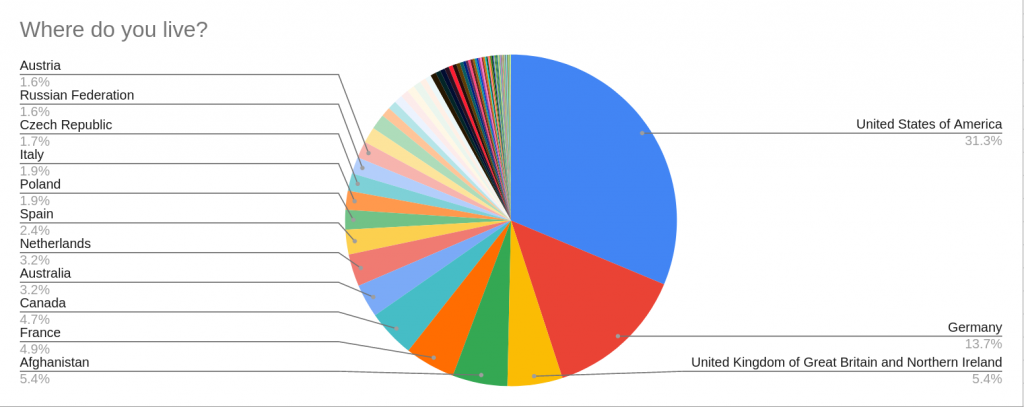

Linux literacy
The vast majority of respondents report being highly Linux literate. A tenth of all respondents consider themselves true Linux wizards and nearly half identify as enthusiasts capable of writing (some) code. A sixth of all respondents reported being ‘tech-heads’ with a good understanding of Linux operating systems.
Non-Linux-savvy users, and people interested in smartphones but with a limited understanding of Linux, are but a small percentage of the sample.
While the PinePhone undoubtedly caters primarily to a Linux literate and technically savvy crowd, I do not believe this result to be representative of the entire community. I strongly suspect that community members with a lower Linux literacy are significantly underrepresented in this poll. Here is one plausible explanation: PinePhone owners with a lesser interest in Linux and FOSS in general do not follow our blog, forum, chats and social media, etc, and therefore haven’t had the opportunity to partake in the poll.
There is also something to be said about the subjective scale used to evaluate respondents’ Linux literacy - more specifically, I think it likely that a portion of the respondents may have overestimated their degree of Linux knowledge. To be clear, this isn’t a snarky jab at respondents, just a known psychological bias found in nearly all self-evaluation forms.
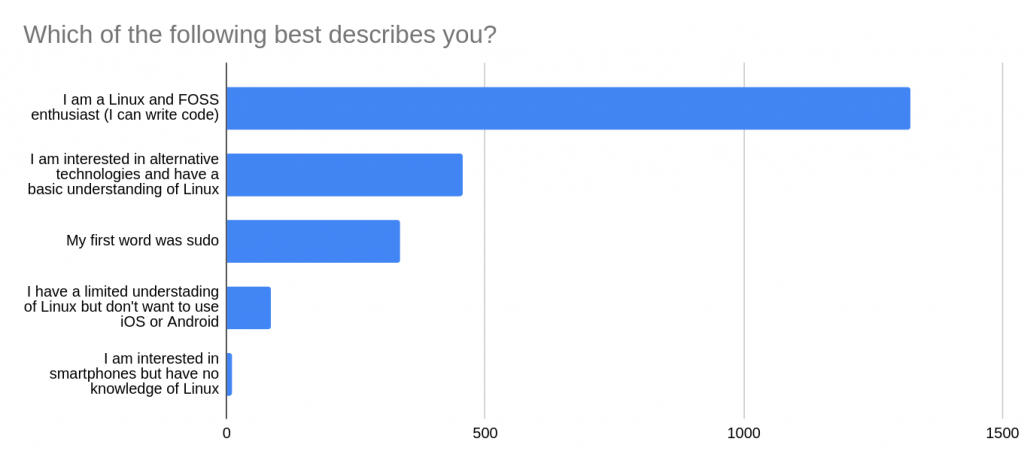
Experience with mobile Linux (capable) smartphones
Although the majority of users reported the PinePhone being their first Linux smartphone, I was surprised to learn that just under a fourth of all respondents have previous experience with mobile Linux. This value is much higher than I expected. I suspect that this result is not representative of the entire PinePhone community.
It would be interesting to learn whether the majority of people with previous mobile Linux experience belong(ed) to the Ubuntu Touch, SailfishOS, Nokia N900 communities, or whether their experience stems from elsewhere.

Poll results
PinePhone usage
I was excited to find that a fourth of all respondents daily drive their PinePhone. Over a quarter of all respondents also use their PinePhone as a secondary smartphone, while a third report using their PinePhone occasionally.
I am very pleased to learn that the majority of respondents use their PinePhone frequently or daily. That said, I suspect that the percentage of people daily driving their PinePhone is overrepresented as compared to the entirety of the PinePhone community. Regardless, I am looking forward to the first in-person FOSS conference to see people show up with their PinePhones in hand.
I am, however, most curious about the people who only use their PinePhones occasionally as they make up a third of the sample. Is there a particular scenario when they use the PinePhone? Do they follow development of one or more OS? Do they use it infrequently due to missing features? Are they considering daily driving it at some point? Would they consider using the PinePhone Pro or some other Linux smartphone more regularly? I’d like to know the answers to these questions - it would warrant a poll of its own.

OS and UI choices
Most respondents - just over a third - have Manjaro Linux installed on their PinePhone. Mobian and postmarketOS appear to be equally popular, with more than a fifth of installs each. DanctNIX (Arch) is in fourth place with approximately an eighth of all installations. Ubuntu Touch arrives in fifth place, accounting for less than a tenth of PinePhone OSes.
Most frequently tried operating systems are: Manjaro, Ubuntu Touch, postmarketOS and Mobian - respectively and in this order. In retrospect I feel that the question inquiring about which OSes tried out was not well phrased. Presumably most people get to experience Manjaro with Plasma Mobile as it ships with the PinePhone, and this cannot be equated with actively seeking out and installing other operating systems. I therefore find it hard to interpret Manjaro’s position at the forefront of this graph.
One interesting observation is that many people try out Ubuntu Touch but end up settling for a different OS. I am curious as to why: is it because Ubuntu Touch is not a traditional Linux distribution? Is it because the PinePhone build lacks some core functionality? Or is it simply the case that our core user base is after a different experience?
As for user interfaces: about a third of all respondents have a preference for Phosh and a fifth for Plasma Mobile. One in ten respondents reports liking Lomiri best. Somewhat surprisingly one in ten respondents has a preference for either SXMO or SWMO (approx 5% each) - this is more than I’d expect given the novelty and complexity of the UI(s). I suspect that the high number of respondents using SXMO and SWMO reflects on the high degree of Linux literacy in the survey sample.
What I find by far the most interesting, however, is the fact that nearly a quarter of all respondents do not have a strong UI preference (whatever works best). I admit that I expected people, many of whom identify themselves as enthusiasts, to have, how should I put it, preconceived UI preferences. Perhaps the Linux community isn’t as partisan when it comes to desktop environments as people say.
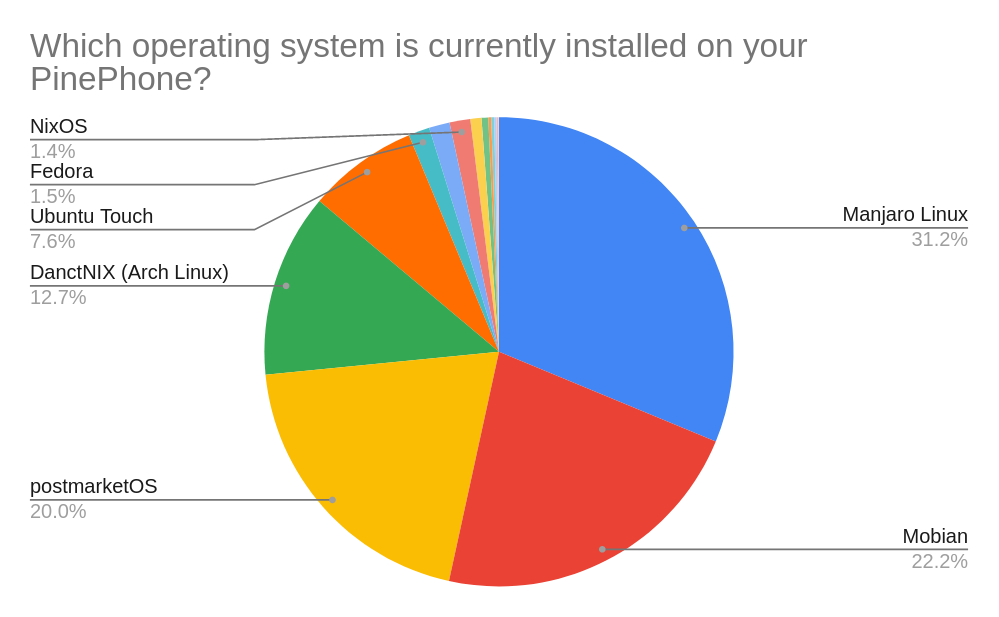
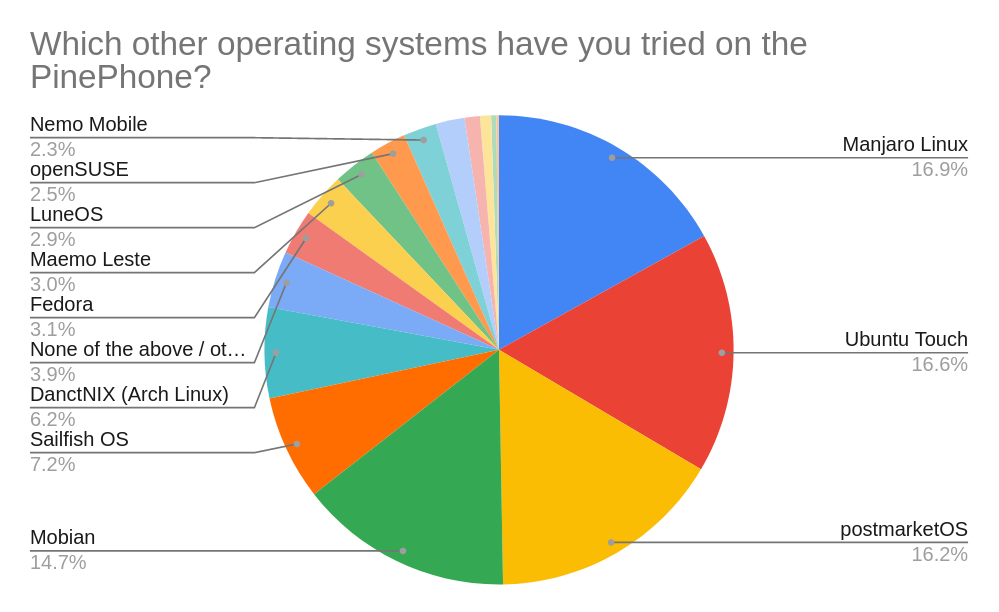

PinePhone Pro and add-ons
Over half of poll participants indicated that they will be purchasing a PinePhone Pro - a fifth stated they’ll be picking one up as soon as it becomes available (the survey launched prior to the PinePhone Pro becoming publicly available).
A third remain undecided whether they’ll pick up a PinePhone Pro but only less than a tenth do not intend on picking one up.
As for the optional PinePhone (Pro) add-on accessories - clearly the most desirable PinePhone add-on is the keyboard case, with nearly two thirds of all respondents planning on purchasing it.
A quarter of respondents plan on purchasing the keyboard add-on case in combination with one of the other add-ons. Aside from the keyboard, the most popular back cases for the PinePhone (Pro) are the fingerprint reader and Qi wireless charging add-ons.
A quarter of all respondents will not be buying any add-ons for their PinePhone.
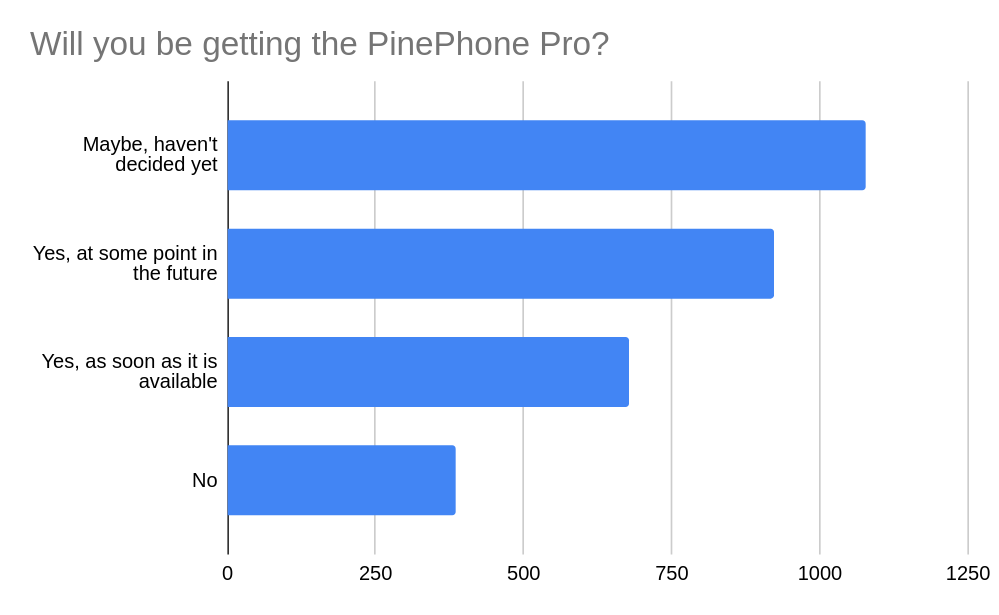

Data compilations
Favorite OSes for daily driving
The majority of users who daily drive their PinePhone use either Mobian or Manjaro Linux - both of which account for just under a third of installs each. postmarketOS and DanctNIX (Arch) come in second and third place with a fifth and a seventh of all installations respectively.
While it is undeniably true that this poll sample is not representative of the entire PinePhone community, I do find it likely that these OSes are the four most popular on the PinePhone platform. Therefore it also makes sense that they are frequently chosen for the purpose of daily usage. Conversely, other OSes are much less popular among the core PinePhone base and therefore also less frequently chosen for the purpose of daily driving.

Favorite OSes among those who use their PinePhone as a backup/secondary smartphone
Among those who use their PinePhone as a backup or secondary smartphone, Manjaro Linux is the most popular OS with nearly a third of all installations. Mobian is the second most popular, with a quarter of all installations, followed by postmarketOS and DanctNIX (Arch) with approximately a fifth and a seventh of installations respectively.
I suspect that a sizable portion of people who use their PinePhone as a secondary smartphone keep the default OS image - Manjaro with Plasma Mobile - as their default installation. Data indicates that only half of people who use their PinePhone as a backup smartphone have tried out other OSes. This stands in contrast to the vast majority of people who tried out other OSes prior to settling on one to daily drive.

Favorite UI among people who drive their PinePhone daily
Phosh is by far the most popular UI among those who daily drive their PinePhones with a presence on nearly 40% of all installations. This is more than likely due to Mobian - which features Phosh by default - being a popular choice for daily driving.
Interestingly, SWMO and SXMO are collectively as popular among those who daily drive their PinePhone as Plasma Mobile, with approximately a seventh of all installations. I am surprised by how popular these UIs are among the PinePhone user base. As you’d expect those who daily drive OS installations with SWMO and SXMO identify themselves as highly Linux literate.
A fifth of respondents in this subsample do not have a UI preference.
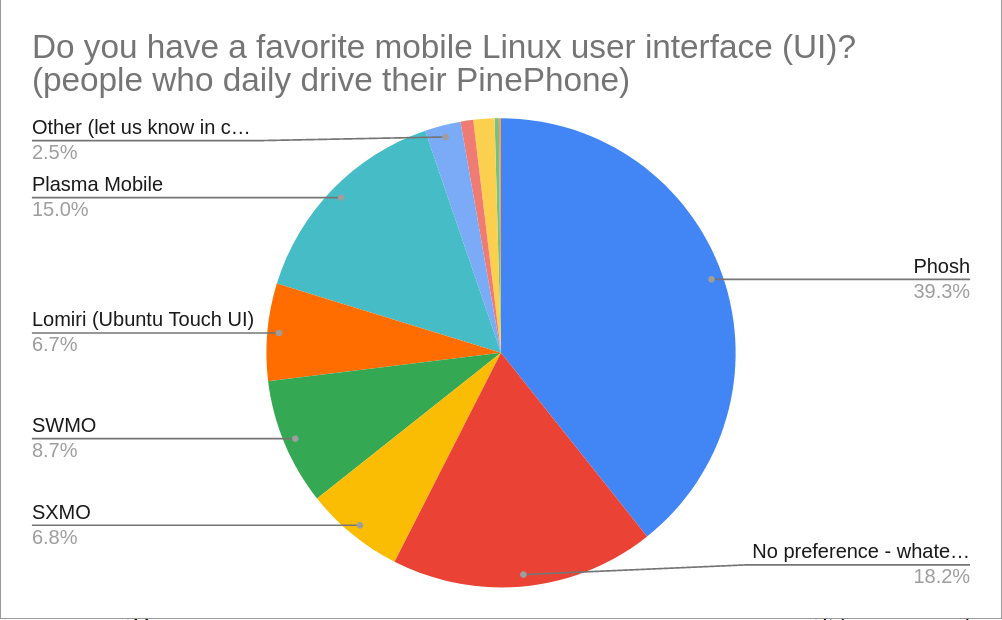
Favorite UI among people who use their PinePhone as a backup/ secondary smartphone
Phosh is the most popular UI for people who use their PinePhone as a secondary smartphone with a third of all installations, while Plasma Mobile comes in second with a fifth of all installations.
A tenth of all respondents in this subsample chose Lomiri as their favorite UI. This is interesting, since this number is comparatively large when contrasted with Ubuntu Touch’s popularity on the PinePhone. I suspect that this indicates people like the Lomiri UI but find obstacles elsewhere in the Ubuntu Touch OS, leading them to switch to one of the four most popular OSes. In other words, they like the UI the best but don’t actually use the OS that offers it.
A fifth of all respondents in this subsample do not have a UI preference.

UIs on the four most popular OSes (Manjaro, Mobian, postmarketOS and DanctNIX)
Plasma Mobile is the most popular UI among Manjaro, accounting for a third of all installations. This is quite predictable given that the default OS image installation shipping on the PinePhone offers this exact OS-UI combination. That said, Phosh is nearly as popular with just under a third of all respondents selecting it as their favorite. A quarter of Manjaro users claim that they do not have a strong preference for any UIs, as long as the UI is efficient and bug-free.
Unsurprisingly Phosh is the UI of choice for Mobian users, half of which selected it as their preferred UI. Interestingly, a fourth reported not having a strong UI preference.
The most interesting results, at least in terms of UI, are to be found among respondents currently running DanctNIX (Arch) and postmarketOS. While both user bases report favoring Phosh, a significant number of users selected SXMO and SXMO as their preferred UI(s). On postmarketOS this number amounts for a whopping third of all respondents; on DanctNIX the number accounts for a seventh of respondents in this subsample. A tenth of DanctNIX users also selected Lomiri as their favorite UI, which is curious since it isn’t available on Arch. Plasma mobile has been chosen by a fifth and a tenth of postmarketOS and DanctNIX users respectively.
This means that SWMO and SXMO are collectively more popular among postmarketOS than Plasma Mobile and comparatively popular among DanctNIX users.
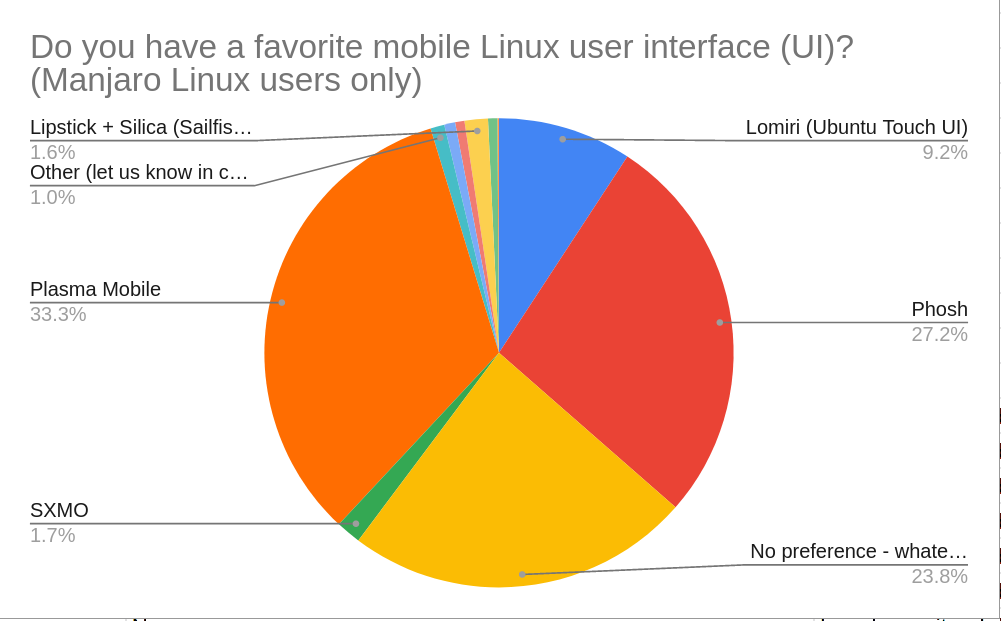
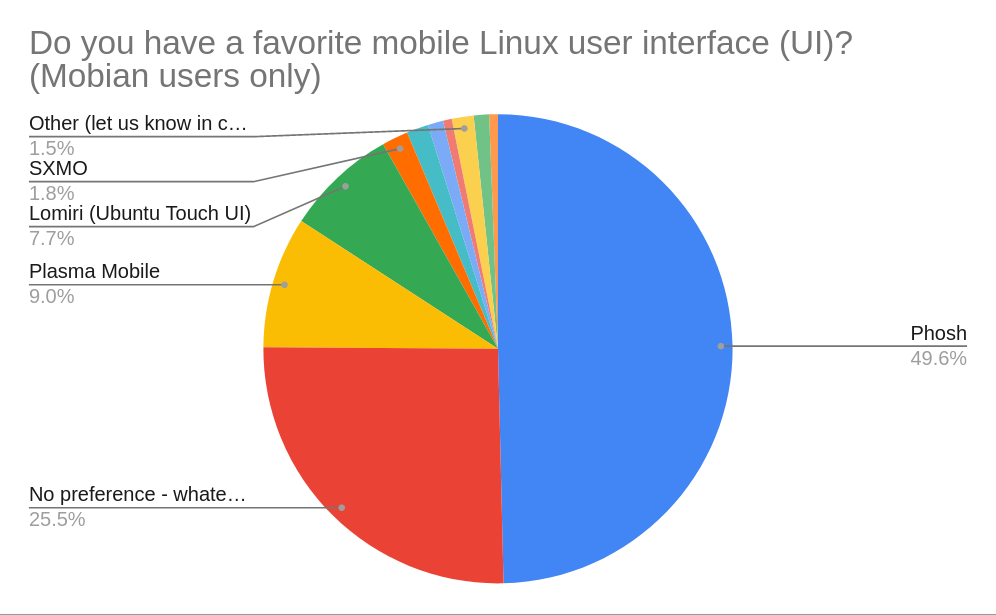
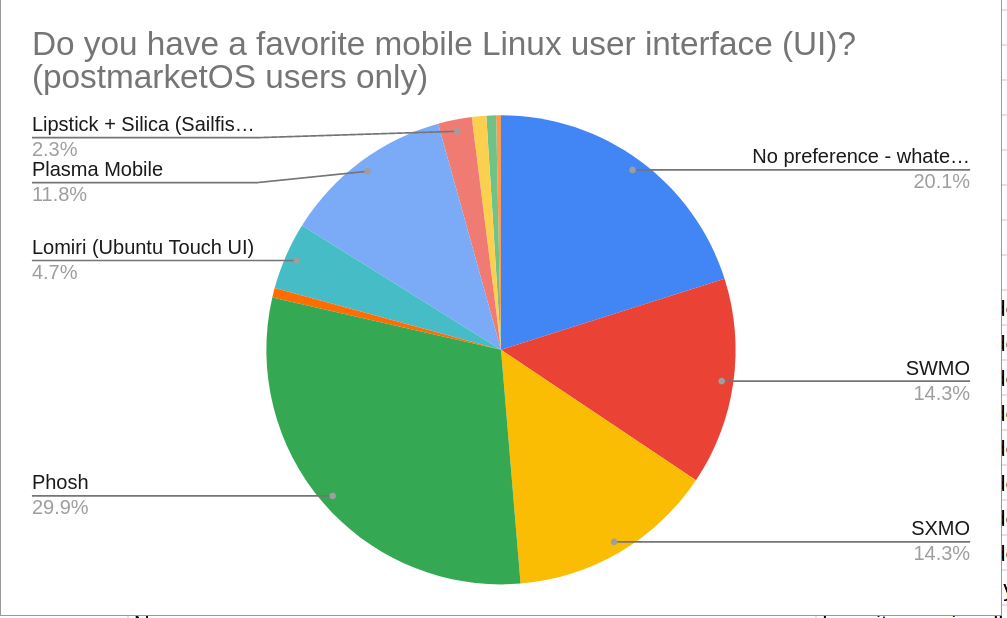

Closing thoughts
I am sure that some of you will be tempted to jump to conclusions having read the poll results and the compilation data, but I strongly recommend you refrain from doing so. I remind you that the sample consists of 3079 respondents, a number which cannot be viewed as representative of the entire PinePhone community. Moreover, due to the methodology, or rather lack thereof, it is impossible to extrapolate results from this data set in a way that would reliably reflect trends in the broader community.
So, then, what is the data good for? I believe that the poll paints a couple of interesting trends among the most active and engaged members of our project. For one, it shows us that this segment of the community views themselves as highly Linux literate - and this is likely accurate (to a degree). PinePhone owners who partook in the poll are also likely to daily drive their PinePhone or use it frequently as a secondary smartphone. It is clear that among this segment of the community four operating systems are most popular: Manjaro, Mobian, postmarketOS and DanctNIX (Arch). Manjaro and Mobian being clearly preferred for daily driving the PinePhone.
We also learned that users of the aforementioned OSes have different UI preferences. While Phosh is clearly the most popular UI across the board, it came as a genuine surprise to me how popular SXMO and SWMO are in general and on postmarketOS more specifically. I didn’t expect such a complex and unorthodox UI to gather such a following in a relatively short period of time. But to be clear, I think this is great. We also shouldn’t overlook that a sizable portion of respondents is indifferent to which UI they use as long as the experience is solid.
I feel we also learned that many respondents like the Lomiri UI and many of them try out Ubuntu Touch on their PinePhone but ultimately decide against using it. To me this is an important finding, with potentially very important implications. Exploring this further, however, falls outside the scope of these poll results (and would likely require a study of its own).
I was glad to see so many respondents planning on picking up a PinePhone(Pro) keyboard to augment their mobile Linux experience. I can tell you that, indeed, the keyboard add-on is very popular and currently one of the best selling items in the Pine Store.
Finally, I am glad to see so many respondents are planning on picking up a PinePhone Pro now or in the future. This is obviously good news for us, our community and the mobile Linux crowd in more general. In a year it may be worth running a similar poll inquiring about the PinePhone Pro to learn whether we met the expectations with our new device.
Once again, I’d like to thank everyone who took part in this poll, I really appreciate it.
_Found a mistake? Please let the mods know or leave a comment below
_


